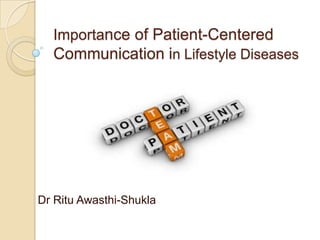
Importance of Patient-Centered Communication for Lifestyle Diseases
- 1. Importance of Patient-Centered Communication in Lifestyle Diseases Dr Ritu Awasthi-Shukla
- 2. Disease Transition Communicable Non Communicable Diseases Diseases (Lifestyle Diseases)
- 3. Communicable Diseases Tuberculosis, Malaria, Cholera, Influenza, Measles, Polio etc Transmitted from one person to another through a causative agent directly or indirectly Prevalent among lower stratum of the society Line of treatment and management is simple and easy to follow Acute diseases
- 4. Non Communicable Diseases Lifestyle Diseases Changes to the way people live have created new environmental and behavioral risk factors, leading to a rise in lifestyle diseases start slowly and often asymptomatically but last longer Type 2 diabetes, Cardiovascular Diseases, Hypertension, Stroke Management of lifestyle disease requires change in living pattern, attitude and mindset
- 5. Improved quality of living and awareness are the only prerequisite of overcoming these diseases “The diabetic who knows the most, lives the longest”- Elliott P. Joslin, 1929
- 6. What Doctors say about patient….. People are not ready to listen and change so it‟s difficult to bring about positive changes Patient hide useful information on the first visit It is easier to change the mindset of the people when somebody has suffered in the family.
- 7. What Patients want from Doctors Make the patient aware that majority of the diseases are preventable and this prevention costs only a minimum of expenditure, if compared to the cost incurred on the treatment. Awareness of right treatment options for the patient. In addition to prescribing medicines to the patients, Doctors should also give some time to educate the patients and attendants about the causes of various diseases and what measures should be taken to prevent the common ailments which can be serious at times if neglected
- 8. A study published in JAMA found that 72% of the doctors interrupted the patient‟s opening statement after an average of 23 seconds Patients who were allowed to state their concerns without interruption spoke for only an average of 6 more seconds
- 9. Patients are at fault too….. Patients described as “frustrating” by doctors do not trust or agree with the doctor present too many problems for one visit do not follow instructions are demanding or controlling
- 10. Traditional Model Linear/ Unidirectional Communication Biomedical approach to addressing medical problems ”Prescription followed” ”weight loss” “Healthy Diet” Symptomatic Treatment “Patient as diseases/ organ”
- 11. Why is it important? Compliance with the medical treatment Improves Patient‟s satisfaction Improved health and emotional status of the patient Improves Doctor‟s satisfaction Reduces Malpractices (Stewart and Roter)
- 12. Barriers to effective communication There may be many barriers to effective physician-patient communication. Patients may feel that they are wasting the physician's valuable time; omit details of their history which they deem unimportant; be embarrassed to mention things they think will place them in an unfavorable light; not understand medical terminology; believe the physician has not really listened and, therefore, does not have the information needed to make good treatment decisions
- 13. Culture and D-P Communication How illness is discussed and treated in a culture Myths and misconceptions already prevalent in the society Poor Language skills
- 14. Types of doctor–patient relationship* Patient Control Doctor’s Control Low High Low Default Paternalism High Consumerist Mutuality *Stewert and Roter
- 15. Default relationship Patients adopt a passive role even when the doctor reduces some of his or her control, with the consultation therefore lacking sufficient direction
- 16. Paternalistic Relationship Doctor is dominant and acts as a „parent‟ figure who decides what he or she believes to be in the patient‟s best interest Patient Submissive
- 17. Consumerist Relationship the patient taking the active role and the doctor adopting a fairly passive role, acceding to the patient‟s requests for a second opinion, referral to hospital, a sick note, and so on
- 18. Relationship of mutuality active involvement of patients as equal partners in the consultation meeting between experts‟, in which both parties participate and engage in an exchange of ideas and sharing of belief system The doctor brings his or her clinical skills and knowledge Patients bring their expertise in terms of their experiences and explanations of their illness, and knowledge of their particular social circumstances, attitudes to risk, values and preferences
- 19. Changing Role of Doctor Patient-Centered Communication Biopsychosocial approach Facilitator/ Listener Behavior Change Expert Negotiating small changes “Patient as person”
- 20. Collective Role of Doctor and Patient Shared decision making Patient preferences should be sought out and validated Doctor and Patient engage in a reciprocal relationship
- 22. “While the doctor focuses on illness, the patient may be more interested in wellness.” Athena du Pre
- 23. Thank you
